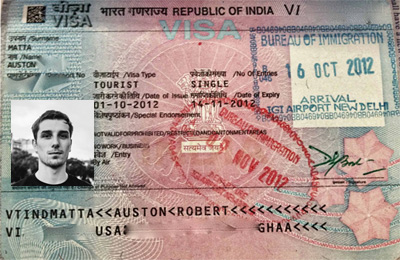Useful Information
Currency
The Indian rupee is in power in India.
Language
In India the official language is Hindi, spoken mainly in the North. In India there are a thousand and more languages and dialects, so often the Indians themselves to understand themselves speak English. English is commonly spoken by almost the entire population and taught in schools.
Climate and Clothing
The North enjoys a year-round desert climate with peaks of over 40 °C in the summer months. In February / (March is the climate is mild.. Heavier clothing is recommended for the evening, comfortable shoes for hiking.
Electricity
In India 220 volts. The sockets are circular with three poles, ours can only be used if with two outputs. In any case, it is better to have a universal adapter especially for charging mobile phones.
Fees for photography
For some years all over India museums and historical and/or archaeological sites ( although external ) ask for the payment of a municipal tax (which is fine for the maintenance and restoration of the sites ) called “room fee”. Usually to be able to photograph you pay 200-300 Rupee sometimes even less depends on monuments you pay directly.
Meals and Drinks
Remember that Indian cuisine varies from region to region the Indian meal consists of a wide choice of cooked vegetable dishes and sometimes meat or fish, accompanied by Rice and lentils (dhal, the typical dish). Do not miss the sauces of various kinds, often spicy, and the many types of local bread (chapati, naan, roti, etc., we suggest You to try the cheese cooked Indian (paneer) and the famous tandoori dishes (meat or fish marinated in lemon juice, spices and yogurt and cooked in a special clay oven). In all hotels meals are buffet style, with a choice of local and international dishes. The national drink is of course tea, which is never served with lemon, but in its English variant, with milk or black. To taste is the so-called chai a hot drink made from boiled milk, tea and spices.
Entry formalities

Foreign Nationals desirous of coming into India are required to possess a valid passport of their country. Government of India has introduced Tourist Visa on Arrival facility (which must be requested at least 72 hours in advance) enabled by Electronic Travel Authorization (ETA) to facilitate foreign travellers visiting India to nationals of following countries :
Australia, Brazil, Cambodia, Cook Islands, Djibouti, Federated States of Micronesia, Fiji, Finland, Germany, Indonesia, Israel, Japan, Jordan, Kenya, Kingdom of Tongo, Laos, Luxembourg, Mauritius, Mexico, Myanmar, New Zealand, Miue, Norway, Oman, Palestine, Papua and New Guinea, Philippines, Republic of Kiribati, Republic of Korea (i.e South Korea), Republic of Marshall Isalands, Republic of Nauru, Republic of Palau, Russia, Samoa, Singapore, Solomon Islands, Thailand, Tuvalu, UAE, Ukraine, USA, Vietnam, Vanuatu. List of more countries eligible for TVoA may be notified by Government from time to time.
Australia, Brazil, Cambodia, Cook Islands, Djibouti, Federated States of Micronesia, Fiji, Finland, Germany, Indonesia, Israel, Japan, Jordan, Kenya, Kingdom of Tongo, Laos, Luxembourg, Mauritius, Mexico, Myanmar, New Zealand, Miue, Norway, Oman, Palestine, Papua and New Guinea, Philippines, Republic of Kiribati, Republic of Korea (i.e South Korea), Republic of Marshall Isalands, Republic of Nauru, Republic of Palau, Russia, Samoa, Singapore, Solomon Islands, Thailand, Tuvalu, UAE, Ukraine, USA, Vietnam, Vanuatu. List of more countries eligible for TVoA may be notified by Government from time to time.
- You are advised not to drink water from tap or roadside vendors. You should only drink boiled or bottled water. It is also better to buy bottled water from respectable and decent looking outlets.
- Avoid eating fresh cut fruits from roadside vendors. Only eat fruits that you can peel.
- It is suggested to keep a mosquito repellent ointment with you.
- It is advisable to carry basic emergency medicines that you might need, especially medicines for upset stomach, vomiting, fever, etc.
- Avoid fountain drinks and ice cubes from unreliable sources.
- Avoid eating food from the roadside vendors. If, by chance, you are tempted to eat there, you should ensure that the food is well cooked and is served hot.
- Most of Indian dishes are spicy. Ask hotel or restaurant to using less or no spices for you. This is very important especially in the initial days of your travel.
- If you are visiting India during summer period, drink lots of safe water. Cover your head with a scarf or hat and use sunscreen lotion to prevent skin damage. It is better to stay indoors in the afternoon.
- If you fall sick, it is better to consult a doctor, You may ask your hotel or local persons whom you know.
- As per necessity measures you need to wear mask and keep using hand sanitizer when required.
Do’s and Don’t’s
- Dress codes for religious places can include covering your head, being barefoot etc. So carry a scarf to cover your head in such places.
- As summers in India are quite unpleasant especially during the day so drink lots of water and fluids. A sunscreen is a must to protect the exposed body parts. Also carry sunglasses to protect your eyes from the scorching sun.
- Photography at many places may not be permissible, and if permissible then only at a fees. Please note that there is usually a higher fee for using video camera.
- Smoking is not permitted at public places.
- English is spoken by almost all the tourist guides. You can also ask for Government- trained and approved guides who also speak Italian, French, Spanish German, Russian or Japanese.
- In India, public toilet facilities are few and far between, so take every opportunity you can to use a clean toilet in places such as hotels and restaurants. Make this a habit wherever you go in India.
Please note:
* Some temples do not permit leather articles in their premises and certain areas of the temples are not open to Non-Hindus.
